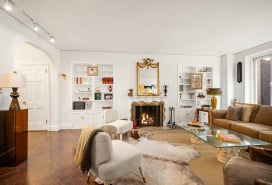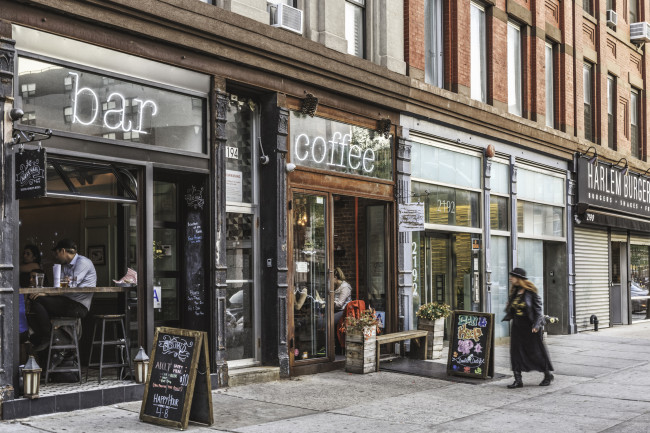A Brooklyn group says yes to affordable housing but no to 13-story towers
- At a meeting, community group Housing Not High-Rises made the case for 'contextual, affordable housing'
- Hanif holds sway over Arrow Linen's rezoning proposal and said affordability is the priority—not height

Arrow Linen is seeking a rezoning to allow the development of two, 13-story buildings with about 244 residential units on Prospect Avenue in Windsor Terrace.
Jennifer White Karp for Brick Underground
Is it financially possible to create affordable housing without building towers so tall they change the feel of a low-rise New York City neighborhood?
That thorny question was at the heart of a heated meeting Tuesday evening organized by community group Housing Not High-Rises in Windsor Terrace, Brooklyn, a few blocks from 441 and 467 Prospect Ave., the location of Arrow Linen, a commercial textile provider.
Arrow Linen, which is looking to relocate its Brooklyn operations, is seeking a rezoning to allow the development of two, 13-story buildings with about 244 residential units (as of right, or without a zoning change, a developer could only build a three-story building). It is also seeking a waiver of parking requirements to enable it to build more units and would replace a one-story building with open space. The resulting mid-block, 299,000-square-foot complex would straddle two streets lined with three-story brownstones.
A community organizes
In the early fall of 2023, Housing Not High-Rises (previously known as Arrow Action), a group of South Slope and Windsor Terrace renters and homeowners, formed in opposition to Arrow's project with the stated goal of supporting “contextual, affordable housing.” The group began holding meetings in the community. The April meeting notice put in neighborhood mailboxes describes Arrow’s plan as “a pure cash grab to enable Arrow to sell their property for more money to a developer.”
A pro-housing group Open New York has also distributed its own flyers and created a petition in support of Arrow Linen’s plans. (Full disclosure: I live a few blocks from Arrow Linen’s complex.)
A desperate need for affordable housing
There is a desperate need to create more housing in NYC, especially affordable housing. This neighborhood is part of the 39th Council District, which The City reported has produced only 700 new units of affordable housing in the past nine years, citing data from the New York Housing Conference, which ranked it 27 out of 50 total districts for new affordable housing units.
The response to this project, both opposed and in favor, is emblematic of discussions about housing taking place all over NYC.
‘Walkability and sense of human scale’
Tuesday night’s meeting, attended by about 300 people at Holy Name of Jesus Church, opened with slides presented by Housing Not High-Rises member Jack Walsh, including an illustration showing how the towers would cast shadows in roughly a two-block radius.
Walsh and others introduced themselves by highlighting their neighborhood roots, such as which local schools they attended. The deep connections were striking, considering most of the time you meet people in NYC who are from somewhere else.

Walsh stated the group’s goal was to protect the neighborhood from “outsize and predatory spot rezoning.”
“We want responsible, truly affordable housing without displacement,” he said.
That’s a reference to the fact that Arrow Linen’s plan would also rezone nine, privately owned rowhouses at 455-465 Prospect Ave. with 59 rent-stabilized units.
Julia Harris, another member of the group, said that rent-stabilized tenants there are “vulnerable to speculators.” (Because of rent-stabilization rules, tenants have to be bought out if an owner is demolishing the building.)
“There is a need for new housing,” Harris said, adding that any new development should “enhance what makes this part of Brooklyn special—its walkability and sense of human scale.”
Residents don’t want “a wall of luxury glass towers,” she said to applause from the audience.

The company is also seeking a zoning amendment to establish the project area as a Mandatory Inclusionary Housing (MIH) project. This would require whoever is developing the project to set either 25 or 30 percent of the units for tenants (there are two different options proposed) at 60 to 80 percent of the area median income (AMI)—a metric that depends on how many people you live with.
Currently, 100 percent AMI in New York City for a three-person household is $127,100, so 60 to 80 percent AMI would be $83,880-$111,840.
Another member, Kate McCabe, explained what the group would want to see instead: towers of five to seven stories with 50 percent of units designated affordable. And they want the buildings that are not owned by Arrow Linen to be “carved out of the rezoning.”
A citywide conversation
Bearing much of the focus of the evening’s presentation was City Council Member Shahana Hanif, who leads the 39th District and will have much sway over the fate of the proposal.
“The conversation about housing is much larger than Windsor Terrace,” Hanif told the audience. “Every citywide elected official is looking at housing as a top priority. Building, supply, and affordability are part of the conversation.”
Another big part of that conversation is Mayor Eric Adams’s City of Yes plan. This is a proposed citywide rezoning intended to add more housing to every NYC neighborhood. It would “remove obstacles to building,” Hanif explained, and for the first time require developers to abide by mandatory affordability requirements.
One of the concerns of Housing Not High-Rises is that Arrow is seeking a zoning map change from R5B to R7-1. Under City of Yes, any R7-1 zoning could get additional floor area, increasing as-of-right zoning to Arrow’s site by about 32 percent, and growing the allowed height of the building from 13 to 15 stories.
But Hanif said this is not the case here. She said she has a commitment from Arrow that the allowed height will remain 13 stories, a requirement that would be passed along to the new owner in the form of a community benefit agreement.
How tall is too tall?
But to many in the audience on Tuesday night, even 13 stories is too tall.
Melissa Olson, who said she rents on Prospect Avenue a block from Arrow, addressed the audience, explaining low-rise buildings that don’t blot out the sky define the area for her. “When I get off the subway from Manhattan, I breathe a sigh of relief,” she said.
She said she believes six stories would be appropriate for the allowable height of the project, and asked Hanif to commit to a position on the height of the tower. Hanif declined, to dismay from the crowd. Affordable housing is her priority, Hanif said, not height.
The proposed development would add nearly 800 new residents to the area, according to an environmental assessment statement filed on April 5th.
Another audience member, a father of a child who attends nearby P.S. 10, said the school is facing a loss in funding because of under-enrollment, which he argued is because families can’t afford to live here. He said he is in favor of Arrow’s plan.
"How are we going to get hundreds of families to move to our neighborhood if we don’t build hundreds of homes?” he asked. His question was followed by a brief but raucous response that included shouts of “I want to live in a high rise,” and “go back to Manhattan!”
The aftermath
Following the meeting, members of Housing Not High-Rises shared a statement with Brick that said in part that they are disappointed with Hanif’s refusal to consider building height.
“We think brownstone Brooklyn is a municipal treasure worth protecting, and we're deeply disappointed to hear that the person who represents the largest swath of brownstone Brooklyn in the city doesn't share our view that this historic neighborhood is worth preserving, or even think that that's something worth considering in making land use decisions. We hope she'll listen to her constituents and reconsider her position,” the statement said.
Hanif, through a spokesperson, declined to provide a statement, as is her policy for projects like Arrow’s that have not begun the ULURP process.
Arrow Linen shared a statement with Brick that said it is “proud of the proposed project as it will enable a family-owned commercial laundry business to relocate to a more industrial area of New York City and bring badly needed housing to a neighborhood that has not kept pace with housing development trends in Brooklyn and citywide.”
The firm has “performed extensive outreach” and met with local elected officials, the Community Board and the Department of City Planning, it said. “We have already modified our initial proposal based on some of these meetings where we received valuable early feedback…We look forward to certification and to entering the ULURP process where community members and elected officials have ample opportunity to weigh in on the project further.”
You Might Also Like































